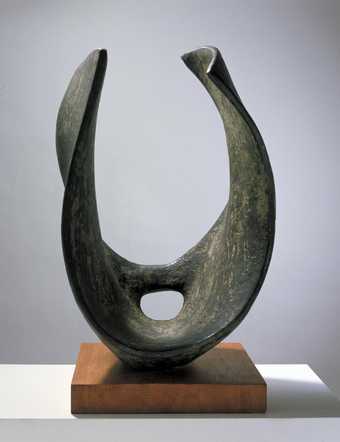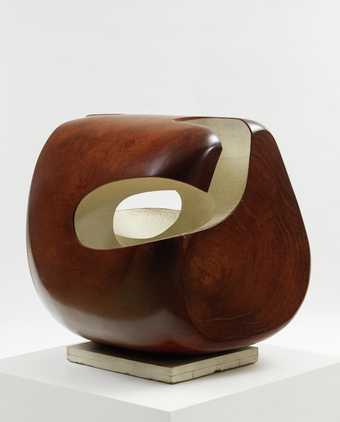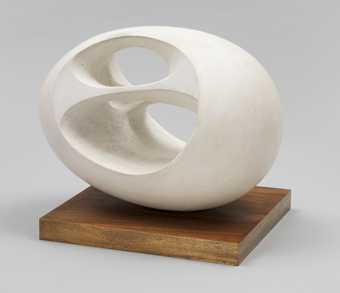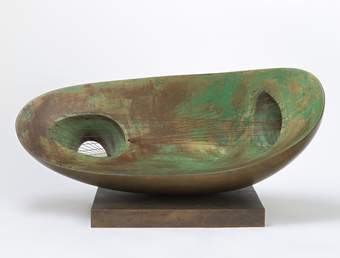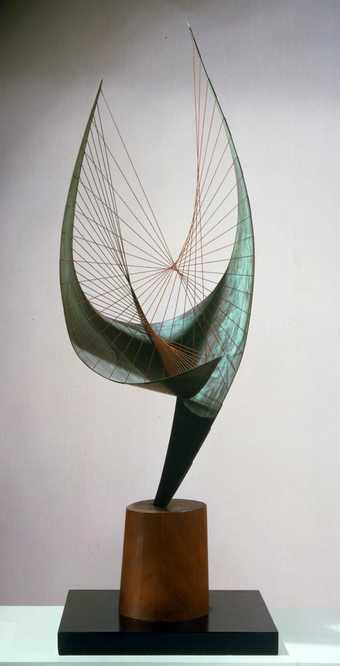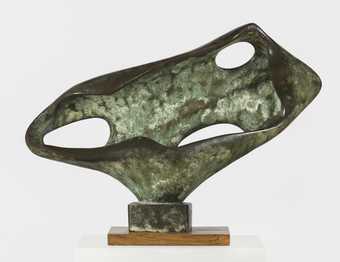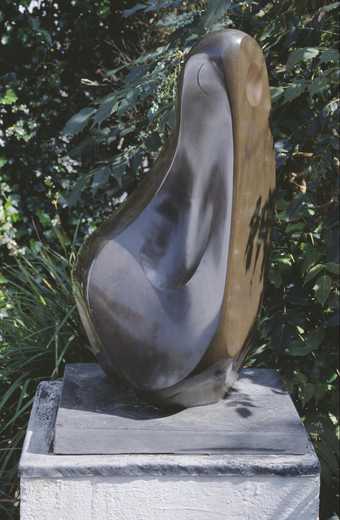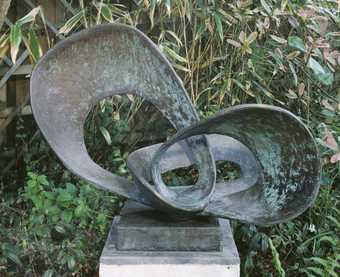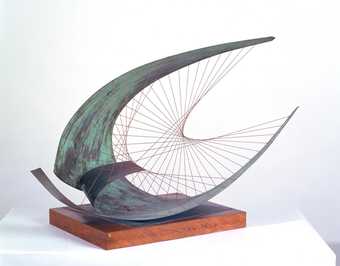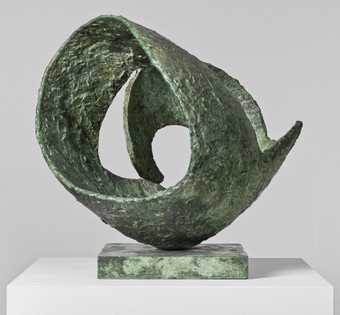
In Barbara Hepworth Museum and Sculpture Garden
- Artist
- Dame Barbara Hepworth 1903–1975
- Medium
- Bronze on wooden base
- Dimensions
- Object: 60 × 190 × 102 mm
- Collection
- Tate
- Acquisition
- Presented by the executors of the artist's estate 1980
- Reference
- T03154
Catalogue entry
Dame Barbara Hepworth
1903-1975
T03154 The Artist's Hand 1943-4, cast 1967
BH 434; cast 2/7
Bronze 58 x 186 x 92 (2 3/8 x 7 5/16 x 3 5/8) on a mahogany base 30 x 224 x 122 (1 3/16 x 8 3/4 x 4 13/16)
Cast foundry mark 'CIRE P[ERDU] | Morris Singer | FO[UNDRY] | LON[DON]' and cast inscription '2/7'on end of wrist
Presented by the executors of the artist's estate, in accordance with her wishes, 1980
Exhibited (ý = unidentified cast, ü = other cast):
Barbara Hepworth: Carvings and Bronzes, Marlborough Gallery and Marlborough Gallery, New York, May-June 1979 (26ý, repr. p.13, as Barbara Hepworth's Hand (1943-4), not NY)
Literature:
Alan Bowness (ed.), The Complete Sculpture of Barbara Hepworth 1960-69, London 1971, p.44, no.434
Tate Gallery Acquisitions 1980-2, London 1984, p.125, repr.
Robert and Nicholas Robins, 'Hands and the Artist: Barbara Hepworth', Journal of Hand Surgery, vol.13-B, no.1, Feb. 1988, p.104, repr.
Reproduced:
Barbara Hepworth: A Pictorial Autobiography, London 1970 & 1978, p.47, pl.133
David Fraser Jenkins, Barbara Hepworth: A Guide to the Tate Gallery Collection at London and St Ives, Cornwall, London 1982, p.10, repr. p.26
Displayed in the artist's studio, Barbara Hepworth Museum, St Ives
The original plaster for The Artist's Hand
was not included in Alan Bowness's 1961 catalogue of Hepworth's work; it was dated 1943-4 in his second volume in relation to the 1967 bronze cast. Though it is now bolted to its base at the ball of the thumb and the tip of the middle finger, it has previously been reproduced in a vertical position and without a base (Robins 1988, p.104). Photographs in the artist's album of works (Tate Gallery Archive) show that the palm may also be viewed, giving the piece a more iconic status than its current, more incidental, recumbent setting. A later sculpture of a hand - Hand I (vertical), 1949-50 (BH 162, artist's estate, not reproduced) - was also designed to be shown vertically.
In making a sculpture of a hand, Hepworth followed the precedent of Rodin, whose late work includes numerous bronzes of a single or several hands at rest and in action. The hand was an established sculptural subject and it may be that the casting of The Artist's Hand
was, in part, stimulated by the 1965 exhibition La Main: Sculptures
at the Galerie Claude Bernard, Paris, to which Hepworth lent a cast of her Hand II (horizontal), 1949-50 (BH 163, repr. artist's albums, Tate Gallery Archive).
That Hand II was her first bronze since leaving the Royal College might be indicative of the fact that Hepworth saw the human hand as of great significance. For her it was, generally, an indicator of human vitality and, specifically, a symbol of the creative sensibility of the artist. Consequently, hands feature repeatedly in her work. The artist John Wells, recalling his time as Hepworth's assistant (summer 1949, 1950-1), has described how she worked incessantly, even making plaster casts of his hand in the evenings. It was, he said, 'part of her training' (interview with the compiler, 15 Oct. 1996). The plaster Hand I (vertical)
and the bronze Hand II (horizontal)
both date from that period. The former has not been reproduced and it appears the latter was originally modelled in clay on the hand of surgeon Norman Capener, a friend of the artist.
In many of Hepworth's hospital drawings of 1947-9 special emphasis is laid on the figures' hands and eyes. In Concentration of Hands No.1, 1948 (British Council, repr. Alan Bowness, Barbara Hepworth: Drawings from a Sculptor's Landscape, 1966, pl.30) and Hands Operating, 1949 (New Art Centre, repr. ibid., pl.28) the hands are the principle, or only, focus of the composition. The artist later described how she saw a delicate operation on a hand as an 'example of the difference between physical and spiritual animation' and how the contrast of 'the inanimate hand asleep and the active, conscious hand' made her 'look in a new light at human faces, hands when people are talking' (A Pictorial Autobiography, 1970, p.51). One of her assistants reported that, c.1960, she made drawings with her right hand of a nodule being removed from the palm of her left hand under local anaesthetic (Tom Pearce interviewed by the compiler, 1 Nov. 1996).
The concentration on eyes and hands echoes Hepworth's conception of sculpture as appealing to both visual and haptic senses. 'Our sense of touch', she said in relation to sculpture, 'is a fundamental sensibility ... the ability to feel weight and form and assess its significance' (ibid., p.53). The touch of a hand is implied in a number of works, for example The Cosdon Head, 1949 (BH 157 Birmingham City Art Gallery, repr. ibid., pl.157), in which a Giacometti-like incised hand introduces a sensual note. Around the time that she made the plaster cast of The Artist's Hand, Hepworth made Hand Sculpture, 1944 (BH 123, Private Collection, repr. in col., Penelope Curtis and Alan G. Wilkinson, Barbara Hepworth: A Retrospective, exh. cat., Tate Gallery Liverpool 1994, p.75), a small abstract carving derived from the example of László
Moholy-Nagy in The New Vision
(1928). The production of a piece designed to be held reiterates the relationship between sculpture and touch.
The artists' hands were used as symbols of their creativity in the publication Unit 1
(1934). David Lewis has described how Hepworth's dominated her outward appearance: 'I remember watching how she felt every surface, not with her fingers but with her palms', he wrote (David Lewis, 'A Personal Memoir, 1947-55, St Ives 1939-64: Twenty Five Years of Painting, Sculpture and Pottery
p.18). In the late 1950s and early 1960s, they were photographed a number of times caressing sculptures and holding tools by the portrait photographer, Cornel Lucas (repr., Robins 1988, p.105). Hepworth also discussed her hands in relation to her work:
My left hand is my thinking hand. The right is only a motor hand. This holds the hammer. The left hand, the thinking hand, must be relaxed, sensitive. The rhythms of thought pass through the fingers and grip of this hand into the stone.
It is also a listening hand. It listens for basic weaknesses of flaws in the stone; for the possibility or imminence of fractures.
(A Pictorial Autobiography, p.79)
The Artist's Hand was cast from her left hand.
Her hand is given an alternative significance by Margaret Gardiner, who has recounted how, before the war, Hepworth had been upset by a palmist who refused to read her palm: 'What horror had that woman imagined that she saw in her hand, what terrible fate? "If only she'd told me", said Barbara, "then I could have laughed it off. But now - why did she refuse"' (Barbara Hepworth: A Memoir, 1982, pp.33-4).
Chris Stephens
March 1998
Explore
- people(22,072)
- named individuals(12,887)
-
- Hepworth, Barbara(304)
- portraits(4,491)
-
- self-portraits(888)
- nationality(18,601)
-
- English(13,010)
- arts and entertainment(7,210)
-
- artist - non-specific(2,109)
- artist, sculptor(1,668)
You might like
-
Dame Barbara Hepworth Curved Form (Trevalgan)
1956 -
Dame Barbara Hepworth Corinthos
1954–5 -
Dame Barbara Hepworth Oval Sculpture (No. 2)
1943, cast 1958 -
Dame Barbara Hepworth Landscape Sculpture
1944, cast 1961 -
Dame Barbara Hepworth Orpheus (Maquette 2) (Version II)
1956, edition 1959 -
Dame Barbara Hepworth Sea Form (Porthmeor)
1958 -
Dame Barbara Hepworth Coré
1955–6, cast 1960 -
Dame Barbara Hepworth Forms in Movement (Pavan)
1956–9, cast 1967 -
Dame Barbara Hepworth Stringed Figure (Curlew), Version II
1956, edition 1959 -
Dame Barbara Hepworth Torso II (Torcello)
1958 -
Dame Barbara Hepworth Involute II
1956

